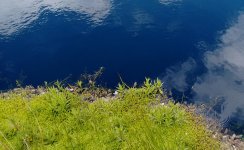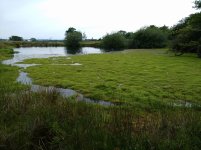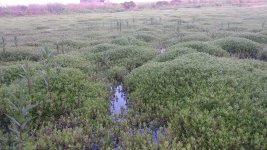Eric Salop
Elite Member
Feeling Blue
The ability to continue to grow over winter is a neat trick for a plant, maybe one that could be turned to advantage one day. With help from the internet I found out that a few trials were going on to see if the growth of Crassula could be halted, or at least reduced, by introducing dye to the water to prevent the underwater leaves from absorbing much sunlight.

I tracked down the company producing this and for 50 pounds (75$) bought enough for at least one years treatment. It is a food grade dye that is similar to that used to color water features in places like golf courses. A reference sample is taken when the dye first goes in, then each month or two you take another sample and compare it with the original. This allows more to be added to make up for what has been diluted away by rainfall or degraded by sunlight. The water ends up a very deep blue.

At first I was very wary handling the dye so as not to get it on my skin. It comes as a fine powder in water soluble bags. As long as you wear gloves and place it gently in the water, it is easy to work with.
Last time I topped up, I wondered what would happen if I threw the bag of dye onto the surface of the Crassula, instead of into the water. The answer was nothing much as far as the weed was concerned. As soon as the rain came it washed off into the water, leaving the surface green again.
The effect on me and our house was more noticeable, though not immediately. That night as I cleaned my teeth, my wife pointed to the basin and in it were streaks of dark blue dye. My hands were clean but my forhead was fringed in blue. I rubbed my hair and my hands were now blue too. I guess some of the powder had come out of the bag into my hair, as I had foolishly thrown the bag overhand to reach further into the pond. With a shower and a good scrub I thought that it was gone and that would be the end of it. Not so, little traces of blue kept popping up all over the place for days and weeks afterwards. It is only noticable when the surface gets wet. Only this week my wife pointed out a small memento on the side of the door that refuses to wipe clean, I will have to sand it out. Oops.

In the long term I may be able to replicate the effect of reducing light in a more sustainable way by introducing some bottom feeding fish to stir up the mud and increase turbidity. Cloudy water may not look as pretty as clear blue, but it's a better prospect than me spending more time in the dog house.
The ability to continue to grow over winter is a neat trick for a plant, maybe one that could be turned to advantage one day. With help from the internet I found out that a few trials were going on to see if the growth of Crassula could be halted, or at least reduced, by introducing dye to the water to prevent the underwater leaves from absorbing much sunlight.

I tracked down the company producing this and for 50 pounds (75$) bought enough for at least one years treatment. It is a food grade dye that is similar to that used to color water features in places like golf courses. A reference sample is taken when the dye first goes in, then each month or two you take another sample and compare it with the original. This allows more to be added to make up for what has been diluted away by rainfall or degraded by sunlight. The water ends up a very deep blue.

At first I was very wary handling the dye so as not to get it on my skin. It comes as a fine powder in water soluble bags. As long as you wear gloves and place it gently in the water, it is easy to work with.
Last time I topped up, I wondered what would happen if I threw the bag of dye onto the surface of the Crassula, instead of into the water. The answer was nothing much as far as the weed was concerned. As soon as the rain came it washed off into the water, leaving the surface green again.
The effect on me and our house was more noticeable, though not immediately. That night as I cleaned my teeth, my wife pointed to the basin and in it were streaks of dark blue dye. My hands were clean but my forhead was fringed in blue. I rubbed my hair and my hands were now blue too. I guess some of the powder had come out of the bag into my hair, as I had foolishly thrown the bag overhand to reach further into the pond. With a shower and a good scrub I thought that it was gone and that would be the end of it. Not so, little traces of blue kept popping up all over the place for days and weeks afterwards. It is only noticable when the surface gets wet. Only this week my wife pointed out a small memento on the side of the door that refuses to wipe clean, I will have to sand it out. Oops.

In the long term I may be able to replicate the effect of reducing light in a more sustainable way by introducing some bottom feeding fish to stir up the mud and increase turbidity. Cloudy water may not look as pretty as clear blue, but it's a better prospect than me spending more time in the dog house.



